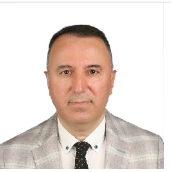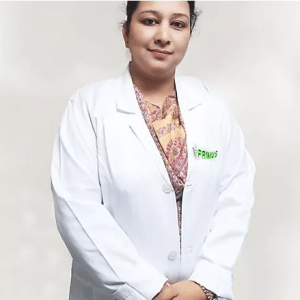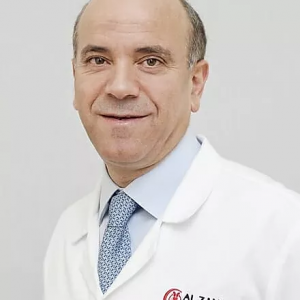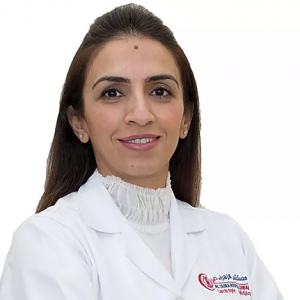Lymphoma Treatment
Overview Lymphoma treatment is available for Lymphoma which is a general term for cancer of the lymphatic system, and it usually develops in a type of white blood cells known as lymphocytes. The lymphocytes play an important role in the defense of the body’s immune system as they help in the fight against diseases. The… Read More
Top Doctors For Lymphoma Treatment Treatments
Top Hospitals For Lymphoma Treatment Treatments
Lymphoma Treatment
Table of contents
Overview
Lymphoma treatment is available for Lymphoma which is a general term for cancer of the lymphatic system, and it usually develops in a type of white blood cells known as lymphocytes. The lymphocytes play an important role in the defense of the body’s immune system as they help in the fight against diseases.
The lymph system, which helps to protect the body, contains vessels and lymph nodes that help the movement of lymph fluid through the body. Contained in the lymph fluid are white blood cells that fight infections. The lymph nodes help prevent the spread of infection by filtering, capturing and destroying viruses and bacteria.
Doctors can treat lymphoma, and in children and young adults aged 15 to 24 years, it is the most common cause of cancer. It is easy for this type of cancer to spread quickly since it is found in the lymph system. Lymphoma can quickly spread to different organs and tissue in the body though it spreads mostly to the lungs, bone marrow, or liver. It can spread to the bone marrow, spleen, thymus, lymph nodes and tonsils. Doctors can treat lymphoma.
The risk factors for both adults and children are the same, although certain types of lymphoma are mostly found among children. Hodgkin’s lymphoma is more common in children of the age group 15 years and younger. However, non-Hodgkin’s lymphoma type, mostly seen in children, is fast-growing and aggressive.
Those that are most at risk of getting lymphoma are the children with the deficient immune system, such as those with HIV, children who are consuming drugs that suppress the immune system and children who have done chemotherapy or radiation therapy.
Stages of Lymphoma
The location of the cancer and whether or not it spreads far will determine the state of the lymphoma. Here are four stages of classification for both types of lymphoma and they include;
- Stage 1: the cancer is seen in one organ site or a lymph node
- Stage 2: the cancer is located in one organ, and nearby lymph nodes or cancer is seen in two lymph nodes that are close to each other and on the same side of the body.
- Stage 3: the location of cancer at this stage can be seen on both sides of the diaphragm
- Stage 4: cancer can spread past lymph nodes that are close by even though cancer can be seen in an organ. Non-Hodgkin’s lymphoma may metastasize as it advances. These organs, including the bone marrow, lungs, and liver, are common locations for non-Hodgkin’s advanced lymphoma. Though stage four is advanced, it can still be treated.
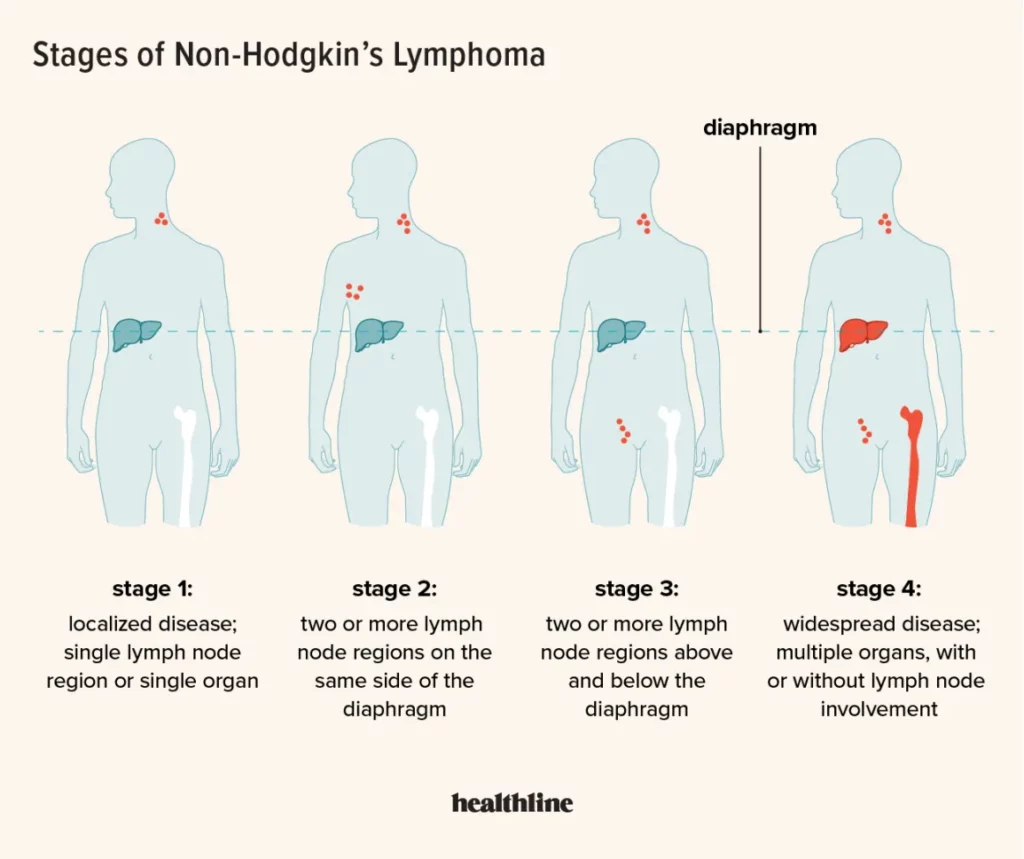
Symptoms of Lymphoma
In the early stages, there may be no symptoms caused by lymphoma; however, during a physical examination, the doctor may notice lymph nodes that are enlarged which usually feel like nodules that are soft and small under the skin. These lymph nodes may be felt in places like the armpit, upper chest, stomach, groin and neck. It is easy to overlook the symptoms of lymphoma during the early stages as the symptoms may be nonspecific, making it difficult to have early detection and diagnosis of early-stage lymphoma. These symptoms include:
- Fatigue
- Chills
- Cough
- Rash that itches
- Shortness of breath
- A spleen that is enlarged
- Itching of the skin
- Appetite loss
- Pain in the stomach
- Weight loss that cannot be explained
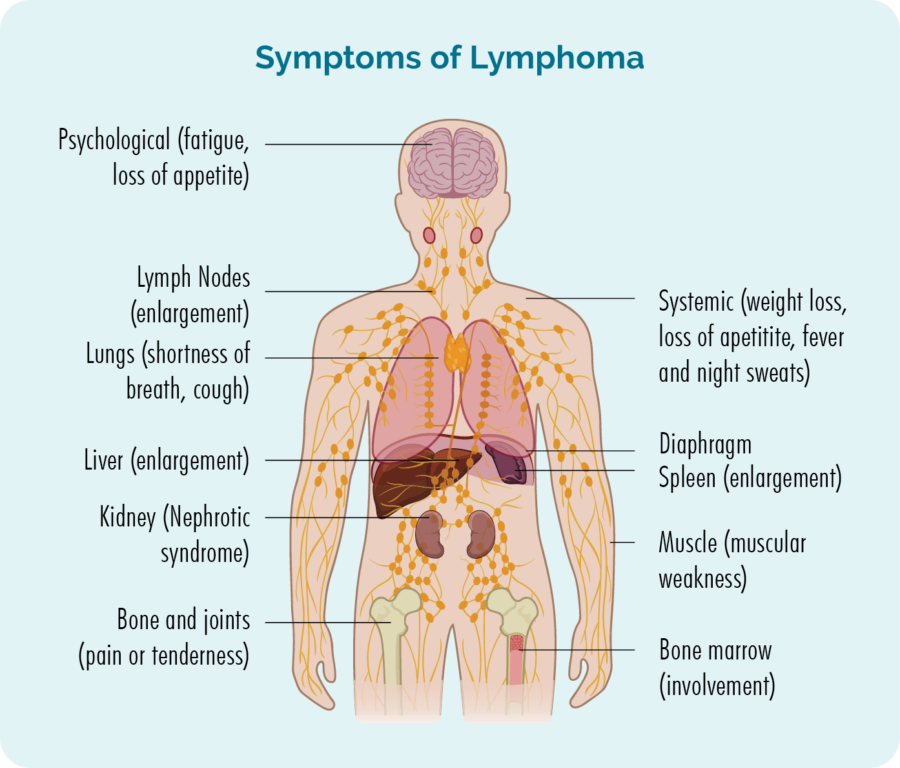
Types of Lymphoma
Hodgkin’s lymphoma and Non-Hodgkin’s lymphoma are the two major types of lymphoma; there are many subtypes within them. While those with non-Hodgkin’s lymphoma don’t have Reed-Sternberg cells (RS), they are associated with Hodgkin’s lymphoma. Reed-Sternberg cells are large, cancerous cells.
Non-Hodgkin’s lymphoma:
This makes up 95 percent of lymphoma cases and is more common than Hodgkin’s lymphoma. A person’s risk of developing this lymphoma in one’s lifetime is 2.2 percent. It begins in the lymphatic system, usually from the B and T lymphocytes. In non-Hodgkin’s lymphoma, not every lymph node is affected by the growth of the tumor, as tumor growth may happen while skipping some. Non-Hodgkin’s lymphoma types are called based on the cells affected by them and if the cells are either slow or fast-growing. According to the American Cancer Society, non-Hodgkin’s lymphoma accounts for 4 percent of all cancer cases, and the B cells are the most affected by the non-Hodgkin’s lymphoma types.
What are the risk factors associated with Non-Hodgkin’s lymphoma?
The following are some risk factors associated with non-Hodgkin’s lymphoma.
- Age: among children and infants, some types of non-Hodgkin’s lymphoma are common; however, in individuals that are 60 years and older, lymphoma is very common.
- Sex: in general, the risk of developing non-Hodgkin’s lymphoma is higher in males than in females. Although in females, some types of non-Hodgkin’s lymphoma are more likely to occur in women than in men.
- Immunodeficiency: people who are immunodeficient may be due to the use of drugs that suppresses the immune system after the transplant of an organ or a weak immune system due to HIV
- Autoimmune disease: the risk of getting lymphoma is increased with those who have some autoimmune disease such as celiac disease and rheumatoid disease.
- Infection: there is an increased risk associated with those who have had certain infections like Heliobacter pylori, T-cell leukemia/lymphotropic virus (HTLV-1), hepatitis C, or the Epstein-Barr virus (EBV).
- Chemical and radiation exposure.: the risk of developing non-Hodgkin’s lymphoma is increased with exposure to nuclear radiation and also exposure to chemicals contained in fertilizers, pesticides and herbicides.
- Ethnicity and location: in the U.S, the risk of having non-Hodgkin lymphoma is lower among African American and Asian Americans than Caucasian individuals. In nations that are developed, it is more prevalent.
- Body weight and diet: although more research is needed to confirm this, it has been suggested by the American Cancer Society (ACS) that there may be some involvement of obesity and overweight in lymphoma development.
Hodgkin lymphoma:
Hodgkin lymphoma is diagnosed through the appearance of Reed-Sternberg cells, which are unnaturally large B lymphocytes. It is a cancer of the immune system. The cancer movement from a lymph node to the adjacent lymph node in people with Hodgkin lymphoma. Though certain risk factors increase the likelihood of getting this cancer, the major cause of Hodgkin lymphoma is unknown. It is estimated that 0.5 percent of all cancers are attributed to Hodgkin lymphoma.
What are the risk factors associated with Hodgkin’s lymphoma?
- Family history: an individual’s chances of getting lymphoma increase if the person’s sibling has been diagnosed with lymphoma.
- Age: those in the age groups of between 20 and 30 and those who are over 55 years are more likely to be diagnosed with lymphoma than others
- Infectious mononucleosis: Mononucleosis is caused by the Epstein-Barr virus (EBV). The risk of developing lymphoma is increased in those with this disease.
- Sex: this type of lymphoma is more common in males than females.
- Immunodeficiency: the likelihood of being diagnosed with lymphoma increases with those who have HIV.
Diagnosis
- Physical examination: The doctor examines for lymph nodes that are swollen, including in the underarm, groin and neck and also checks the liver and spleen for any swelling
- Lymph node removal for testing: The doctor may advise a procedure such as the lymph node biopsy. In this procedure, a part or all of a lymph node is taken for testing in the laboratory. Advanced tests can tell if lymphoma cells are present and the cell types involved.
- Blood tests. This can give the doctor a clue about the diagnosis as the blood cells will enable the count of the number of cells present in a sample of your blood.
- Removal of a bone marrow sample for testing: a sample of the bone marrow is removed via a needle which will be inserted into the hip bone. This procedure is called bone marrow aspiration and biopsy. The sample collected is taken for analysis to check for lymphoma cells.
- Spinal tap: Under local anesthetic, a surgeon will remove and test spinal fluid using a needle that is long and thin
- Imaging tests: Other imaging tests like CT, MRI and positron emission tomography (PET) may be recommended by the doctor to look in other parts of the body for signs of lymphoma.
Depending on the type, cellular characteristics and growth rate, cancer is classified into different stages, with stage 4 spread to distant organs, making treatment very challenging. In contrast, stage 0 or 1 means the cancer is confined to an area. Lymphoma may be said to be indolent, that is, it is in a place or aggressive, that is, it has moved to other areas of the body.
Lymphoma Treatment
The type of lymphoma one has and the stage of cancer will determine the course of treatment.
For slow-growing or indolent lymphoma, treatment may not be needed. Watchful waiting to ensure that cancer doesn’t spread may be enough. Treatment, if needed, will involve the following.
- Biologic therapy: this drug involves the introduction of microorganisms into the body, causing the immune system to be stimulated to attack the cancer
- Chemotherapy: an aggressive medicine is introduced into the body to target and kill cancerous cells
- Radioimmunotherapy: high-powered radioactive doses are delivered directly into the B cells and T-cells that are cancerous to kill them.
- Antibody therapy: synthetic antibodies are administered by a medical professional into the bloodstream. These antibodies respond to the toxins of cancer.
- Radiation therapy: this type of therapy uses doses of radiation that are concentrated to kill cancerous cells. The doctor recommends this type of therapy to target and kill small areas of cancer.
- Transplantation of stem cells: This can help in the restoration of the bone marrow that is damaged after a high dose of radiation therapy or chemotherapy
- Steroids can be injected to treat lymphoma.
- Surgery: after lymphoma has spread, the spleen or other organs may be removed by the surgeon.
References
https://www.mayoclinic.org/diseases-conditions/lymphoma/diagnosis-treatment/drc-20352642
https://www.healthline.com/health/lymphoma#non-hodgkins-lymphoma
https://www.medicalnewstoday.com/articles/146136#treatment
“Medical Advice Disclaimer:
DISCLAIMER: THIS SITE DOES NOT PROVIDE MEDICAL ADVICE OR OPINION:
The information provided in this article or website by way of text, illustration, graphics, Images or any other form in this article or website is provided for informational purposes only. No information or material provided on this site is meant to be a substitute for a professional medical advice. Please refer to your family doctor or specialist in that field for any medical condition, diagnosis and treatment. Do not delay in contacting a professional on account of something you have read in this article or on this website.”








